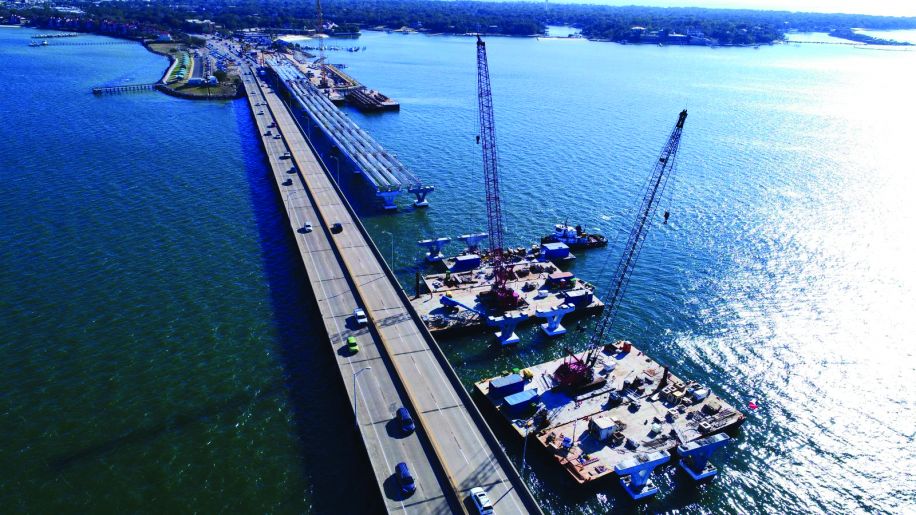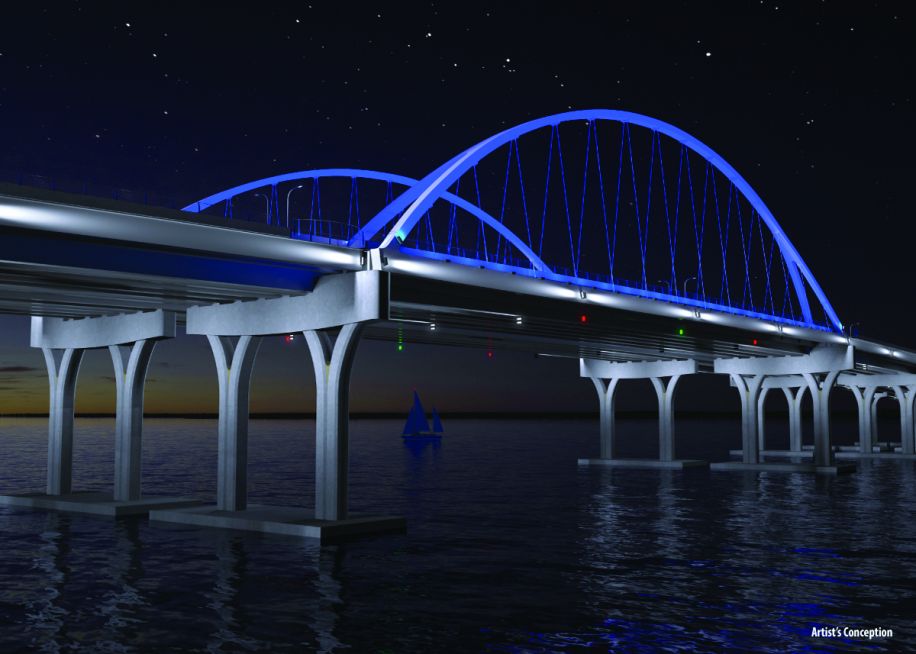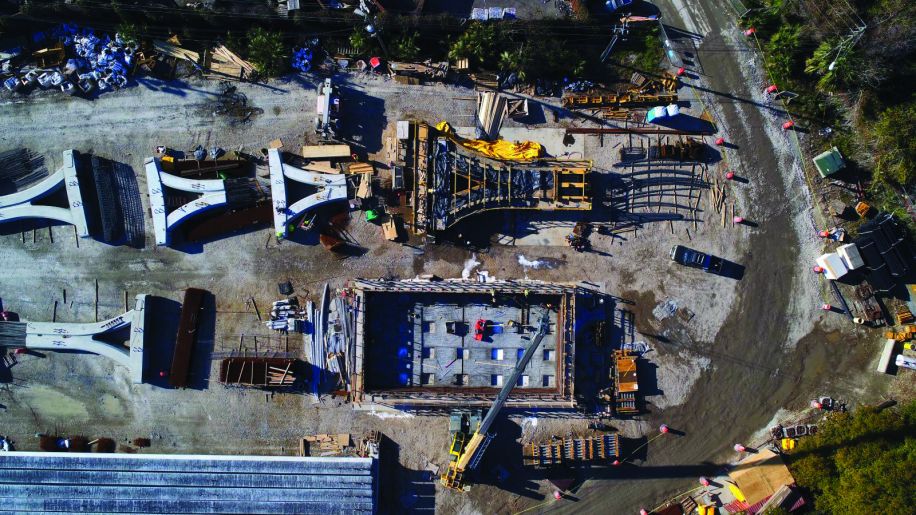By Will Isern
The scale of the new Pensacola Bay Bridge project can be hard to grasp. Hundreds of millions of pounds of concrete. Twenty four million pounds of steel. Four hundred million dollars. The single largest transportation infrastructure project in Northwest Florida history.
“It’s one thing to see it on paper,” said Santa Rosa County commissioner and Florida-Alabama Transportation Planning Organization chairman Rob Williamson. “It’s something all together different to be driving adjacent to this massive change to the vista and entry to both our counties and start to see the size and scope of this bridge come to life right in front of us.”
The project has already been underway for nearly a year. Cranes like crisscrossed skyscrapers tower over the old bridge, maneuvering huge concrete structures into place. The driving of piles echoes across the bay.
The current bridge opened in 1960 and was declared structurally deficient in 2010, having reached the end of its 50-year lifespan. Northwest Florida was fortunate in the years directly afterward to have Don Gaetz sitting as president of the state senate. After leaving office, Gaetz told the story of how the new bridge was originally intended to be a toll bridge. Rather than let that plan move forward, however, Gaetz refused to sign off on the state Department of Transportation’s multi-year work plan for the I-4 corridor unless money was found to fund the bridge without a toll.
“I said, ‘I’m telling you you’re going to have to wait two more years until I’m out of this office, because I’m not signing these documents unless there’s something in this arrangement for Northwest Florida,” Gaetz said at the time.
The FDOT agreed to not place a toll on the bridge, and began soliciting bids for construction. Following a lengthy selection process in 2016, Skanska USA Civil Southeast was selected as the design-build firm to construct the new bridge at a price of $398.5 million.
Based upon Skanska’s design, the new bridge will actually be two identical spans stretching side-by-side across the bay. The first span is being built now, with three lanes, ten-foot shoulders and walking paths on either said. Skanska stands to earn a $15 million bonus if it can complete construction of the first span by Jan. 2019 and move traffic from the current bridge onto the new span. The current bridge will then be torn down and a second, identical span will be built in its place. Total completion is scheduled for summer of 2020.
FDOT spokesman Ian Satter said the project has required intense coordination between FDOT, Skanska and governments on both sides of the bridge.
“First and foremost, it’s a monumental project for us so there’s a lot of work for us, for our contractor and for their subcontractors,” he said. “From day one of this process we’ve communicated with Pensacola, Gulf Breeze and Escambia and Santa Rosa Counties because this project affects all of us.”
The new bridge will be made up of thousands of replications of three main pieces. There are the supporting piles, driven deep into the floor of the bay, the “trophy pieces” that extend like “Y” shapes from tops of the piles, and the horizontal beams that will stretch across trophy pieces, forming the support upon which the driving surface of the bridge will be poured – foot-by-foot – for 3.7 miles.
As well as being wider and taller than the current bridge, the new bridge will also feature several technological upgrades including “aesthetically pleasing bridge lighting” with different color settings, close-circuit video monitoring and a “Wrong Way Detection System”.
The work to build the bridge begins at the Bayou Chico casting yard where 280 daily workers cast the huge concrete structures that are delivered by barge to the new bridge site. There, another 80 workers position, set and fasten the pieces in to place. Crews have recently begun to pour the first sections of the new bridge’s driving surface on the Gulf Breeze side of bridge.
Estimates from the University of West Florida’s Haas Center for Business Research and Economic Development indicate the project is creating or sustaining approximately 4,800 jobs in Escambia and Santa Rosa Counties, along with the rest of the state.
As chairman of the Florida-Alabama Transportation Planning Organization, Williamson said he sees the new bridge as testament to the growth of the part of the state.
“I think when first time visitors land at the airport and come across the bridge, whether they’re going to Pensacola Beach, or Navarre or visiting the Andrew’s Institute, that bridge is going to tell a very favorable story about the growth and direction of this part of Florida,” he said. “We are the future of Florida as it relates to growth and I think this amount of money being allocated here from Tallahassee demonstrates that.”
By the numbers
Cubic yards of concrete: 162,000
Pounds of steel: 23.6 million
Number of piles: 2,124
Number of “trophy pieces”: 416
Number of beams: 1,020
Number of travel lanes: Three east and three westbound (12-feet each).
Number of shoulders: Four, two on each bridge (10-feet wide).
Number of bicycle/pedestrian paths: One on each bridge (10-feet wide).
Average daily traffic count: 55,000 vehicles.
Construction period: 1,408 days (plus allowable delays for weather, etc.)
Construction cost: $398.5 million.
Estimated completion: Summer 2020
Source: Florida Department of Transportation



